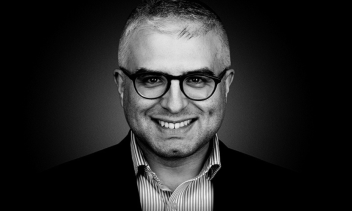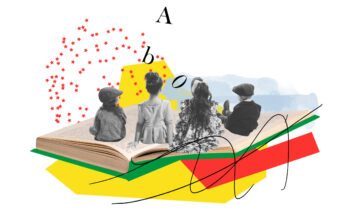Excerpted from Mimini Mikhael – Essays on Yom Kippur and Teshuva, by Rabbi Dr. Michael Rosensweig. Maggid Press, July 2023. Reprinted with permission. For formatting purposes, all 15 footnotes are excluded.
In the final chapter of Hilkhot Teshuvah, Rambam presents a variety of beautiful formulations regarding ahavat Hashem:
העובד מאהבה עוסק בתורה ובמצות והולך בנתיבות החכמה…מפני שהוא אמת וסוף הטובה לבא בגללה. ומעלה זו היא מעלה גדולה מאד ואין כל חכם זוכה לה. והיא מעלת אברהם אבינו שקראו הקב״ה אוהבו לפי שלא עבד אלא מאהבה…וכיצד היא האהבה הראויה הוא שיאהב את ה׳ אהבה גדולה יתירה עזה מאוד עד שתהא נפשו קשורה באהבת ה׳ ונמצא שוגה בה תמיד כאלו חולה חולי האהבה… והוא ששלמה אמר דרך משל כי חולת אהבה אני. וכל שיר השירים משל הוא לענין זה
One who serves [God] out of love occupies himself in the Torah and the mitzvot and walks in the paths of wisdom…because it is true, and ultimately, good will come because of it. This is a very high level, which is not merited by every wise man. It is the level of our Patriarch, Avraham, whom God described as “he who loved Me,” for his service was only motivated by love…
What is the proper [degree] of love? That a person should love Hashem with a very great and exceeding love until his soul is bound up in the love of Hashem. Thus, he will always be obsessed with this love as if he is lovesick…. This concept was implied by Shlomo when he stated, as a metaphor, “I am lovesick” (Shir haShirim 2:5). [Indeed,] the totality of Shir ha-Shirim is a parable describing this [love].
Rambam then addresses the progression from performing a mitzvah for ulterior motives to doing it for correct reasons. Rambam concludes Hilkhot Teshuvah, and by extension Sefer ha–Madda, with this concept.
Interestingly, Rambam then transitions into Sefer Ahavah, which he begins with the motto, “Mah ahavti Toratekha kol ha-yom hi sihati – How much do I love your Torah; it is [the subject of] my constant conversation” (Tehillim 119:97). Rambam thereby conjoins the first two books of the Mishneh Torah with the notion of ahavat Hashem. Why did Rambam conclude Sefer ha–Madda, and more importantly Hilkhot Teshuvah, with a chapter devoted to ahavat Hashem?
This is particularly noteworthy and surprising considering that Rambam devised and devoted an independent ten-chapter section to the laws of teshuvah, which are strewn throughout the Talmud without any cohesion, as the culmination of the first of the fourteen books of the Yad ha-Hazakah, his comprehensive and masterful halakhic magnum opus. Rambam expanded, reorganized, and invested pioneering effort in the formulation of these particular laws. Moreover, Rambam specifically elected to place Hilkhot Teshuvah in Sefer ha-Madda, forgoing the more obvious alternative of locating these laws in a narrower, if more obvious classification, such as Hilkhot Shegagot, Avodat Yom ha–Kippurim, or Shevitat Asor in Sefer Zemanim. The determination that Hilkhot Teshuvah is pivotal to Sefer ha–Madda, and even its appropriate coda, certainly requires clarification. It adds greater urgency to understanding this puzzling choice of dedicating the final chapter of Hilkhot Teshuvah and all of Sefer ha–Madda to the mitzvah of ahavat Hashem.
These questions are compounded by the fact that Rambam already codifies ahavat Hashem in Hilkhot Yesodei ha-Torah at the beginning of Sefer ha-Madda, together with the theological truths that a person is required to affirm to qualify as a believing Jew. It is striking that despite having already addressed the concepts of ahavah and yirah at the very beginning of Sefer ha-Madda, he feels compelled to return to them at the culmination of Sefer ha-Madda in Hilkhot Teshuvah.
Resolution of Rambam
A close examination of Hilkhot Teshuvah reveals Rambam’s intentions. It is no coincidence that Rambam chose the culmination of Hilkhot Teshuvah to ruminate about ahavat Hashem and the motivation and ambition that both suffuse and engender it. By accentuating the importance of ahavat Hashem, by promoting it as an ideal, and by utilizing the metaphor of intense romantic love found in Shir ha-Shirim, Rambam effectively conveys that ahavat Hashem is of paramount importance to all elements of avodat Hashem. Simply put, Rambam’s unusual presentation reflects his profound comprehension that ahavat Hashem is the ultimate telos of teshuvah. He thereby accentuates a perspective that undergirds his entire presentation and classification of Hilkhot Teshuvah and informs and reinforces his classificatory decision.
For Rambam, teshuvah is a necessary, natural component of Sefer ha–Madda and Mishneh Torah more broadly, as it is a mode of avodat Hashem in and of itself. Teshuvah is not exclusively about neutralizing het (sin), but instead an act of avodat Hashem that leads to the highest level of religiosity.
Furthermore, Rambam’s decision to place Hilkhot Teshuvah in Sefer ha–Madda is even intuitive, because his goal is to integrate teshuvah with avodat Hashem throughout the year. Teshuvah is not simply a narrow response to sin; rather, it is itself a pinnacle of avodat Hashem, and therefore an obvious choice for the culmination of Sefer ha–Madda.
Rambam’s choice to conjoin Hilkhot Teshuvah with Sefer Ahavah through the concept of ahavat Hashem flows consistently from this perspective. The transition to daily mitzvot, which are described in Sefer Ahavah, reinforces these themes and accentuates the broader relationship between man and Hashem that is also a key component of the process of teshuvah. Hilkhot Teshuvah, at the culmination of Sefer ha–Madda, is juxtaposed with Hilkhot Keri’at Shema at the beginning of Sefer Ahavah. The laws of Keri’at Shema encapsulate the comprehensiveness of ahavat Hashem – “be-khol levavekha u-vekhol nafshekha u-vekhol me’odekha” – and capture the mission of total religious and halakhic commitment, kabbalat ol malkhut Shamayim. This juxtaposition further broadens the motif of teshuvah and integrates it into the other primary institutions of avodat Hashem.
Rambam’s Consistency on Ahavat Hashem
Rambam’s approach to ahavat Hashem is very consistent. In the passage from Hilkhot Teshuvah cited above, he refers to Avraham Avinu as the exemplar of ahavat Hashem, invoking the verse “Avraham, who loves Me” (Yeshayahu 41:8), the same verse he quotes in Sefer ha-Mitzvot when he discusses ahavat Hashem:
והמצוה השלישית היא שצונו לאהבו יתעלה וזה שנתבונן ונשכיל מצותיו ופעולותיו עד שנשיגהו ונתענג בהשגתו תכלית התענוג וזאת היא האהבה המחוייבת… ולשון סיפרי )שם( ואהבת את ה׳ וכו׳ אהבהו על הבריות כאברהם אביך שנאמר ואת הנפש אשר עשו בחרן. ר״ל כמו שאברהם בעבור שהיה אוהב השם כמו שהעיד הכתוב )ישעי׳ מא( אברהם אוהבי שהיה גם כן לגודל השגתו דרש האנשים אל האמונה מחוזק אהבתו כן אתה אהוב אותו עד שתדרוש האנשים אליו:
The third mitzvah is that we are commanded to love God, exalted be He – that is, to meditate upon and closely examine His commandments and His works in order to understand Him, and through this understanding to achieve a feeling of ecstasy. This is the kind of love that we are obligated to achieve…. [We see that this mitzvah includes spreading love for God to others from] the Sifri: “‘You shall love Hashem’ – make Him beloved among the creatures, as your father Avraham did, as it is written, ‘The souls that he made in Haran’ (Bereishit 12:5).” The meaning of this is that Avraham, as a result of his deep understanding of Hashem, acquired love for Hashem, as the verse testifies, “Avraham, who loved Me.” This powerful love caused him to call out to all mankind to believe [in God]. So too, you shall love Him to the extent that you draw others to Him.
Avraham Avinu is the model of ahavat Hashem for Rambam. In Sefer ha–Mitzvot, he describes a practically uncontrollable impulse, an overflowing sense of ahavah, which overtakes the person. Rambam depicts Avraham as the paradigm of an ohev Hashem, one whose infectious enthusiasm and exuberance to share Torah with others derived from an overflow of his own intoxication with the Ribbono Shel Olam and His Torah. The experience begins with a rational awareness, but it goes beyond that and becomes a religious experience. This is the foundation of Avraham’s method and mission. Avraham’s outreach activity was part and parcel of being “Avraham, who loves Me,” reflecting an unrestrained and overflowing sense of purpose resulting from love of the Divine.
Talmud Torah and Ahavat Hashem
Rambam articulates unambiguously that the primary mechanism for achieving this state of ahavat Hashem is talmud Torah (Torah study). Exposure to the word of Hashem, both Torah and mitzvot, has a transcendent and transformative impact (if one does not resist it), which ultimately leads to ahavah and performance of mitzvot lishmah, for the sake of heaven. Hence, Torah study and observance of mitzvot in their own right are the indispensable foundation for developing ahavat Hashem and fostering authentic avodat Hashem in the model of “Avraham ohavi.”
It is surely no coincidence that some commentators suggest that teshuvah mi–ahavah can be attained primarily through talmud Torah. The connection that Rambam draws between ahavat Hashem and the study of Torah in Sefer ha-Mitzvot, as well as the way he describes the study of Torah in the tenth chapter of Hilkhot Teshuvah, is absolutely consistent with this idea, and indeed reinforces it.
Moreover, it is likely no coincidence that the verse Ramban identifies as the source for teshuvah is related to talmud Torah as well:
כי המצוה הזאת אשר אנכי מצוך היום לא נפלאת הוא ממך ולא רחקה הוא.
For this commandment that I command you this day, it is neither too hard for you nor far off. (Devarim 30:11)
The gemara states explicitly that this verse refers to the mitzvah of talmud Torah, and that is how Rambam codifies it as well. Rambam was obviously keenly aware of these normative sources; by nevertheless identifying this verse as the source for teshuvah, he establishes that Torah study and teshuvah are two sides of the same coin. The intimate connection between talmud Torah and teshuvah supports the notion that talmud Torah is the basis for teshuvah mei-ahavah.
This perspective provides a framework for understanding why talmud Torah is so urgent and why it is so important that the undertaking of Torah study not be performed frivolously or even casually. While Torah study should engender joy, as “the precepts of Hashem are right, making the heart rejoice” (Tehillim 19:9), Torah study should be pursued with reverence and seriousness. The perspective that talmud Torah is the means to connect with the Infinite as the most ambitious expression of avodat Hashem precludes a casual, careless, or trivial approach.
Talmud Torah is both the foundation of the marital relationship between us and the Ribbono Shel Olam and the prime tool for building that relationship. Thus, learning Torah is equal in importance to all the other mitzvot. Moreover, the way one engages in it is critical as well; Torah study requires mind, heart, and soul, demanding the surrender and subordination of one’s mindset and way of thinking to that of the Torah.
This highlights the importance of in-depth Torah study and analysis, which includes the attempt to uncover the subtleties within a topic and connections between topics. While it provides intellectual exhilaration, the excitement engendered by advanced talmud Torah is secondary compared to the spiritual aspiration that accompanies it. At the end of the day, the enthusiasm that we exhibit, the attachment to the topic, the exploration of the options and the nuances, and the analysis of the expressions of the Rishonim and other texts are really about the enthusiastic relationship of ahavat Hashem, which not only impacts teshuvah, but is the basis for avodat Hashem and a broader Torah-infused perspective on life.
Those who share a bench in the beit midrash, study partners who learn together, form a bond based on transformative shared experiences. There can and should be abundant joy associated with the creative process, including initiative and personal contribution, but the ultimate goal is a transcendent one: fostering a community built on shared values and the belief in the importance of Torah study.
As we noted, Rambam concludes Hilkhot Teshuvah with ahavat Hashem and then transitions into Sefer Ahavah. Thus, teshuvah is not a concept restricted to Elul and the Aseret Yemei Teshuvah (the Ten Days of Repentance). Rather, it sets the tone for our relationship with Hashem throughout the entire year.
Rabbi Dr. Michael Rosensweig is a Rosh Yeshiva and the Rosh Kollel of the Beren Kollel Elyon at the Rabbi Isaac Elchanan Theological Seminary (RIETS), an affiliate of Yeshiva University. After studying under Rabbi Dr. Aharon Lichtenstein at Yeshivat Har Etzion and the Rav, Rabbi Joseph B. Soloveitchik at Yeshiva University, Rabbi Rosensweig graduated from Yeshiva College. He received his M.A. and Ph.D. in Medieval Jewish History from the Bernard Revel Graduate School of Jewish Studies, where he wrote his dissertation under the supervision of Rabbi Dr. Haym Soloveitchik. After receiving semicha from RIETS, Rabbi Rosensweig was among the first group to complete intensive postgraduate studies in RIETS’ Caroline and Joseph S. Gruss Kollel Elyon. In 1985, Rabbi Rosensweig was appointed Rosh Yeshiva at RIETS, where he currently holds the Nathan and Perel Schupf Chair of Talmud. In 1997, he was appointed Rosh Kollel of the Israel Henry Beren Institute for Higher Talmudic Studies at RIETS. Rabbi Rosensweig resides in Kew Gardens, Queens, with his wife, Smadar, professor of Bible at Stern College for Women, where they were blessed to raise seven children.








